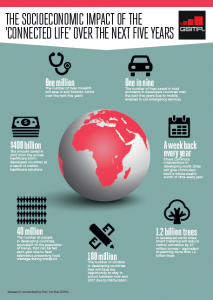 In the fight against malaria, TB, HIV and perinatal conditions, greater use of mobile connectivity could save more than one million lives in sub-Saharan Africa over the next five years. In Europe, the U.S. and other developed countries, mobile healthcare solutions could shave a massive $400 billion off the annual healthcare bill in 201
In the fight against malaria, TB, HIV and perinatal conditions, greater use of mobile connectivity could save more than one million lives in sub-Saharan Africa over the next five years. In Europe, the U.S. and other developed countries, mobile healthcare solutions could shave a massive $400 billion off the annual healthcare bill in 201
These are two of the findings of a new GSMA and PwC study into the potential impact of the Connected Life – leaving mobile connectivity into people’s daily lives and the broader economy. Once connected, electronic devices, machines and vehicles can be monitored and controlled remotely, saving people, companies and governments time and money.
Although millions of new devices and machines are connected to mobile networks every month, we are still just scratching the surface of what is possible. In fact, mobile connectivity could, with the right support, help the human race address many of the greatest challenges it faces today – extending access to healthcare and education, lifting people out of poverty, fighting hunger, combating solutions-and-impact/connectivity-for-good/external-affairs/climate-action/ change and fuelling economic growth, among many others.
NOW IS THE TIME
And this isn’t blue-sky thinking or a vision of the distant future. Over the next five years, the mobile industry, working in partnership with other industries and governments, should be able to dramatically improve the quality of life of hundreds of millions of people around the world.
Here’s another striking example from the GSMA/PwC study: An extraordinary 240 million tonnes of food spoils during transit and storage every year in developing countries. The use of mobile connections to track trucks and monitor the temperature of storage facilities would save enough food to feed more than 40 million people annually – equivalent to the entire population of Kenya
Mobile handsets and mobile connected ereaders and tablets can also be used to provide much broader access to educational materials. The GSMA and PwC estimate that mobile connectivity will provide 180 million children in developing countries with the opportunity to stay in education between now and 2017. This would have a major impact, as education is one of the most potent weapons we have to fight poverty.
Mobile technology can also make travelling safer; in developed countries, one in nine of the lives lost in road accidents could be saved by in-car connectivity that calls the emergency services automatically in the event of a collision, providing accurate location information and other relevant details. In cities, intelligent transport systems, which monitor traffic flows and direct drivers accordingly, can ease congestion, reduce commuting times, lower stress levels and keep the economy moving. In developing cities, the GSMA and PwC estimate that mobile-based traffic management and public transport enhancement could reduce commute times by up to 35 per cent, enabling drivers to reclaim an entire week of their lives each year.
Shorter commutes would also cut exhaust emissions and reduce pollution. Moreover, connected energy meters and smart grids can help utilities companies to reduce waste, save money and lower greenhouse gas emissions by 27 million tonnes in developed nations in 2017 – equivalent to planting more than one billion trees.
THE CONNECTED CITY
Here at Mobile World Congress, you can go and see the Connected Life in action. Building on the success of the Connected House at last year’s Congress, the GSMA and its partners are showcasing the Connected City in Hall 3. This isn’t a model – this is a full-size city street complete with a car showroom, office, town hall, department store, mobile shop, apartment, electrical store, hotel and café.
The Connected City brings to life the very latest connected solutions, such as the world’s most advanced connected road bike, the Aston Martin One-77, which uses sensors embedded into the cranks and frame to display more than 100 channels of information including speed and atmospheric pressure as well as calculated inputs such as rate of climb and rider power. You can also experience how AT&T’s Digital Life solution enables homeowners to manage their energy consumption and household security, while Korean operator KT is showcasing an “edutainment robot”, a smart home phone, an eco-food bin, “cloud CCTV” and many other cutting-edge products and services.
Telenor Connexion and long-standing customer Volvo are demonstrating connected car services, while Deutsche Telekom and IBM have teamed up to show how mobile connectivity can enhance urban services, such as public transport, parking, energy, security and water management. You can also see an array of smart city, smart home and smart mobility solutions from Vodafone, including the use of mobile connectivity to monitor solar energy production and to remotely control street lighting and digital signage.
Hopefully, our Connected City will whet appetites and inspire even more innovation. It is also designed to show both the public sector and the private sector what is possible. Mobile operators can’t deliver the Connected Life on their own – they need to work with other industries and with local and national governments. Let’s change the world, one connection at a time.
In the fight against malaria, TB, HIV and perinatal conditions, greater use of mobile connectivity could save more than one million lives in sub-Saharan Africa over the next five years. In Europe, the U.S. and other developed countries, mobile healthcare solutions could shave a massive $400 billion off the annual healthcare bill in 2017.
This article originally appeared in the Mobile World Congress Show Daily http://www.mobileworldlive.com/show-daily

